Hong Kong’s stock of old buildings is rising, as those built during the construction boom from the 1950s to the ’70s age. Those managed privately or under government stewardship are inspected and repaired. Of urgent concern are housing blocks with no owners’ committee or management supervision. William Xu reports from Hong Kong.
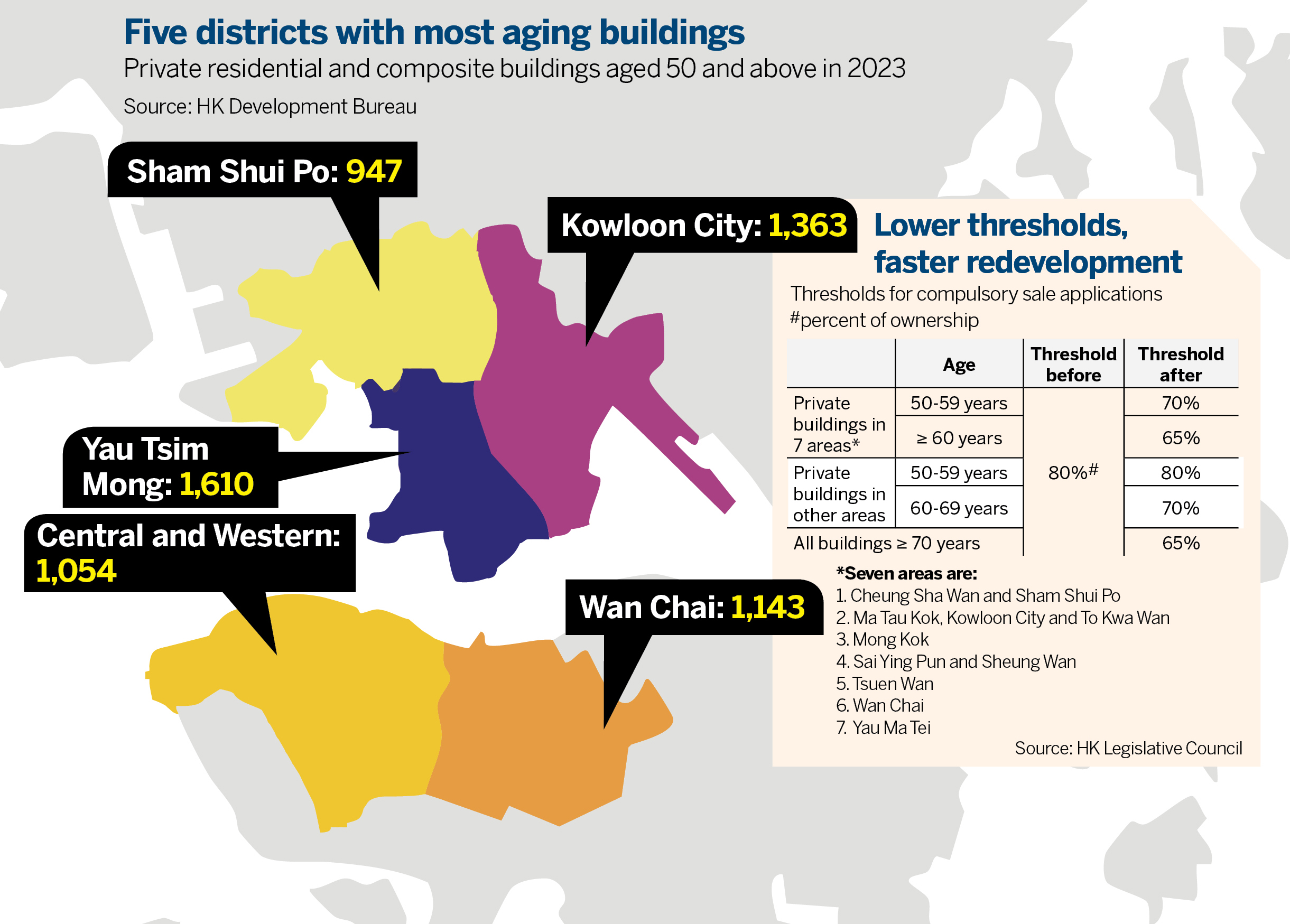
About one in five of Hong Kong’s residential high-rise buildings risk collapse if not repaired. They have reached the critical half-century age alert. Buildings have a lifespan. There will be 500 more buildings joining these ranks every year from now, growing the “50+” stock to more than half the city by 2050.
Hong Kong’s high humidity, summer temperatures, typhoons and rainstorms, corrode pipes and metal structures, crack cement surfaces, spall concrete and peel facades over time.
READ MORE: Government targets fire risks in Hong Kong’s old buildings
The Hong Kong Institution of Engineers has warned that the number of buildings at risk will jump from about 5,000 now, to 20,000 by 2030. It urges prompt action to keep pace with the rising stock of “at-risk” buildings. The Business and Professionals Alliance for Hong Kong (BPA) has suggested the city redevelop 750 of these potentially dangerous buildings every five years.
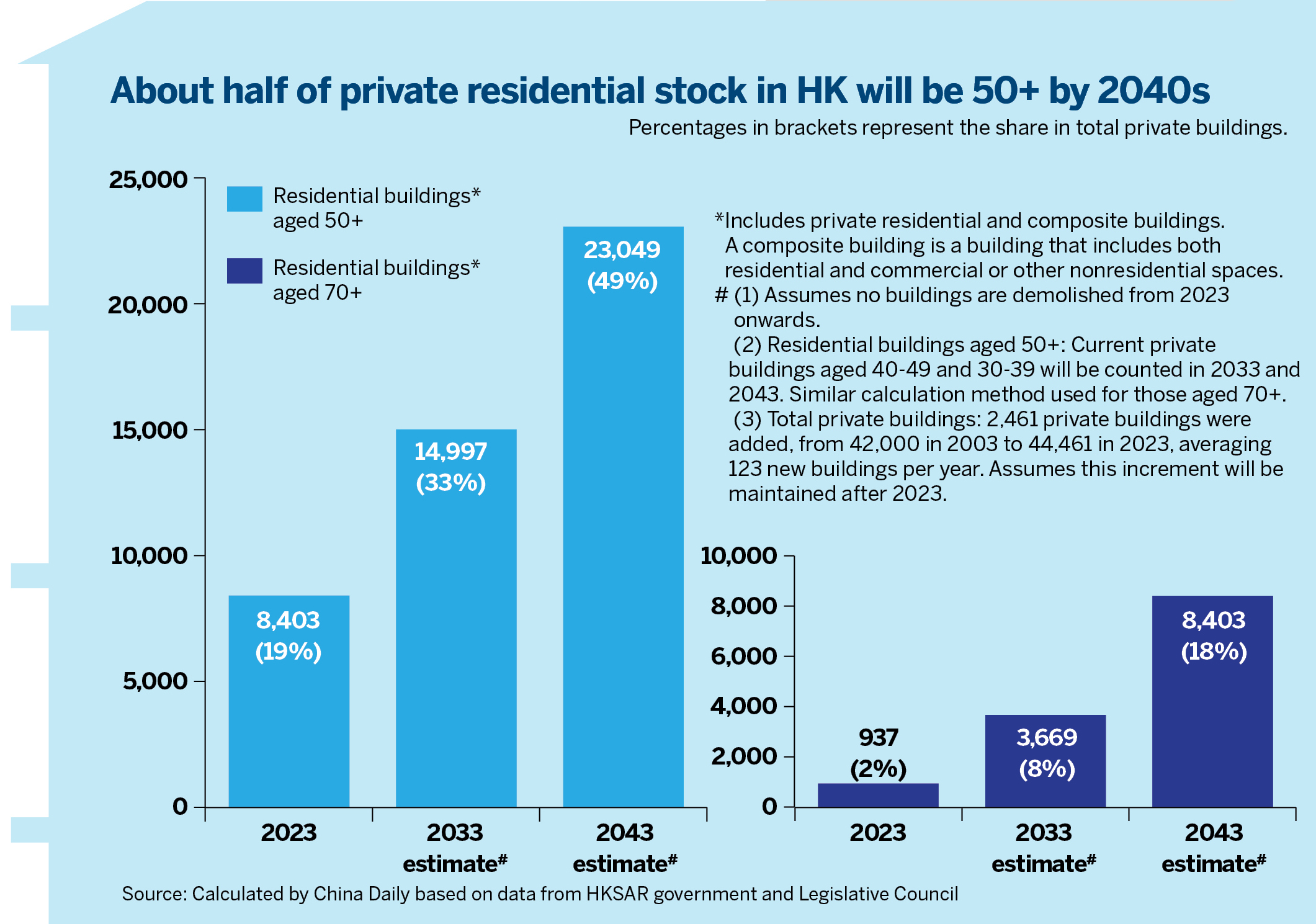
Urban renewal
The alliance has advised the government to provide finance to alleviate the economic burden on the Urban Renewal Authority of borrowing at high interest rates. Establishing a reconstruction fund to ease the financial burden on the URA would be a prudent move in the long run, according to the BPA. The URA is a statutory body created to initiate redevelopment projects, or respond to building owners’ redevelopment calls.
Between 2013 and 2022, 1,650 private buildings were demolished for renewal projects, of which 85.5 percent were implemented by private developers, and 14.5 percent by the URA.
The URA can apply for resumption of land, with its redevelopment sites freed from the land premium — a tax on land transactions — which saved HK$22.9 billion ($2.95 billion) as of March 2023.
However, the URA’s 79 redevelopment projects initiated since its establishment in 2001, with 1,785 structures being rebuilt or undergoing renewal, is a drop in the ocean against the city’s aging building stock.
Elvis Lau Wai-kin, assistant professor at the Technological and Higher Education Institute of Hong Kong, says that the majority of potential redevelopment projects depend on the enthusiasm of private developers.
He suggested more incentives such as allowing the transfer of parts of gross floor areas from redevelopment sites to other projects. Lau urged property owners to pay attention to maintenance, as building facades and plumbing have lifespans. Hong Kong’s high land prices have caused owners to fixate on property asset values, leading to the negligence of maintenance, said Lau.
In October, a URA site in Kowloon experienced a failed tender. Analysts said private developers were guarded on the joint-development offer due to uncertainty in the property retail landscape.
Yu Kam-hung, former president of the Hong Kong Institute of Surveyors, said a vibrant economy is vital to push forward urban redevelopment on buyer confidence.
Yu added that the government can introduce new land uses in urban renewal projects, such as talent apartments, to attract developers. He proposed setting up a central maintenance fund like the Mandatory Provident Fund, requiring all property owners to make a monthly contribution so that when a building needs repairs, any expenses are covered.
The Chinese mainland authorities are mulling over a “housing pension” program to be financed by government and contributions from homeowners to relax residents’ anxiety over aging buildings. In Japan, every household contributes around HK$660 per month to mandatory maintenance funds operated by their buildings’ managing bodies. Hong Kong can refer to these experiences.
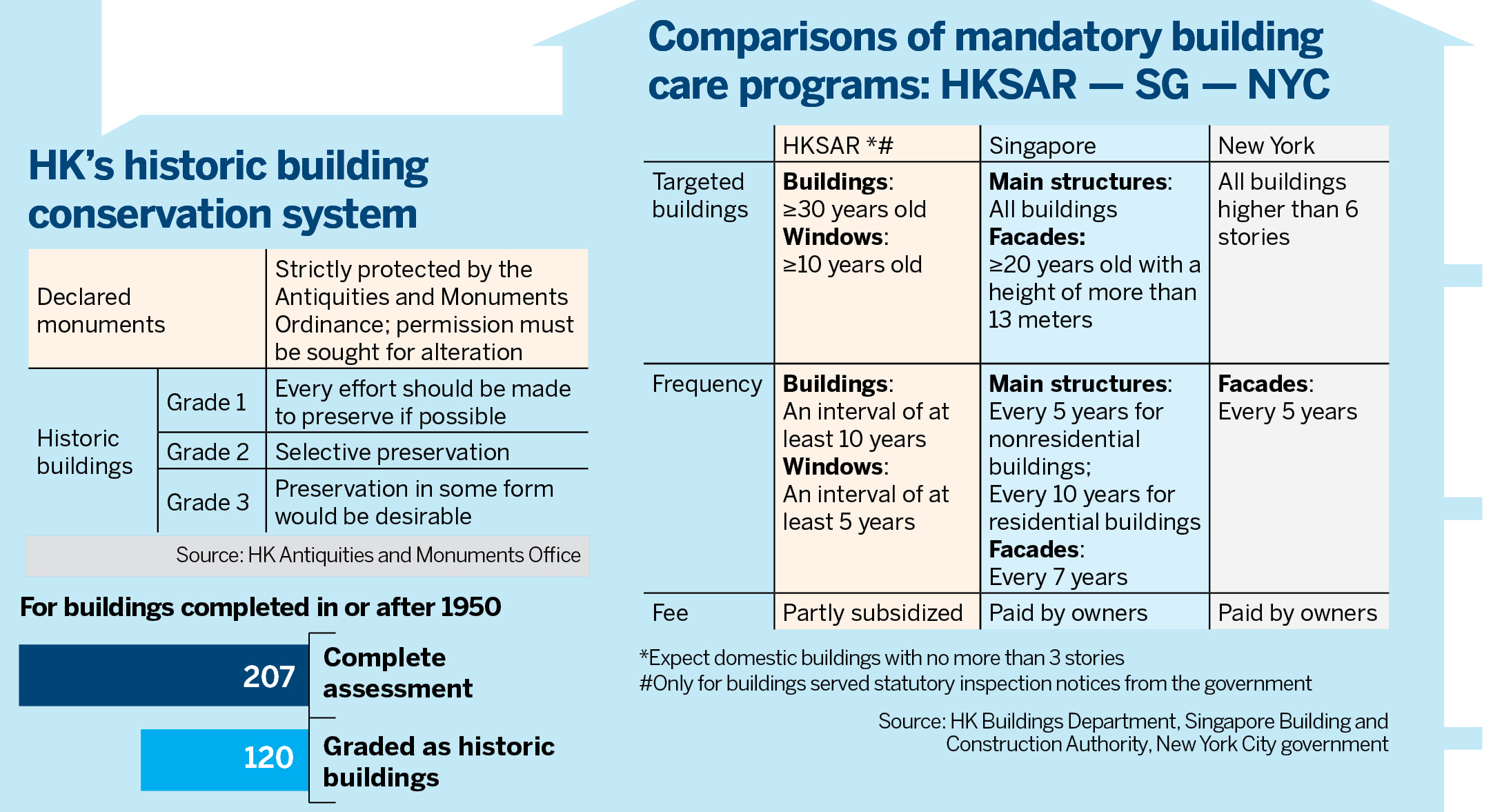
‘Three-nil’ dilemma
Private residential buildings which elect owners’ committees, and those maintained by property management companies, regularly have their structural integrity inspected and common facilities repaired.
Government-owned and subsidized public housing, through the Housing Authority and the nongovernmental Hong Kong Housing Society, benefit from centralized management and scheduled inspections to ensure the physical integrity of structures and facilities such as water supply, refuse disposal and sanitation.
The category with the highest risk are residential buildings that do not have Owners’ Corporations (OCs), residents’ organizations nor property management companies, to inspect, maintain and repair them.
These are referred to as the “three-nil” buildings. In 2023, there were 3,000 such buildings in serious need of inspection and repair. The stock of three-nil buildings reduced from 6,600 in 2011 to 2,900 in 2022 but rebounded to 3,000 last year.
Since 2011, authorities have helped over 640 three-nil buildings establish or resume the operation of OCs — independent bodies on behalf of owners — to manage maintenance. That assumes that owners are able to afford large maintenance repairs.
Legislator Kitson Yang Wing-kit believes that some blocks have opted to dissolve their OCs due to an inability to carry out management and repairs, and has called on the government to fill the gap. Over the last three years, the government has repaired 144 three-nil buildings in immediate risk.
According to District Councilor Jimmy Lam Pok of Kowloon City, many owners are out of contact due to emigration or other reasons, forming obstacles to consensuses and fundraising. “In many cases, owners can only raise about 70 percent of the maintenance fee, so fewer contractors are willing to undertake work on these buildings,” he said. Lam, from direct knowledge of the dire state of several buildings, called on the government to prioritize cases for urgent repair.
The URA, in collaboration with the Hong Kong Institute of Housing, is experimenting with a joint property management mode for three-nil buildings in Kowloon. The trial allows multiple single-block buildings to jointly hire one property management company, so that households in the buildings get basic management services such as regular inspection and notice boards at an affordable rate.
“We hope the Joint Property Management program will be a good opportunity to help residents be aware of their responsibility to manage their own properties,” said HKIH Vice-President Rosita Wong Po-chun.
In July, lawmakers approved lowering compulsory sale application thresholds for old buildings. The URA plans to incorporate catalysts, such as transfer of plot ratio and sizable development areas, in redevelopment road maps for areas like Mong Kok and Yau Ma Tei.
These new mechanisms enhance land-use efficiency and optimize redevelopment potential to encourage private developer participation.
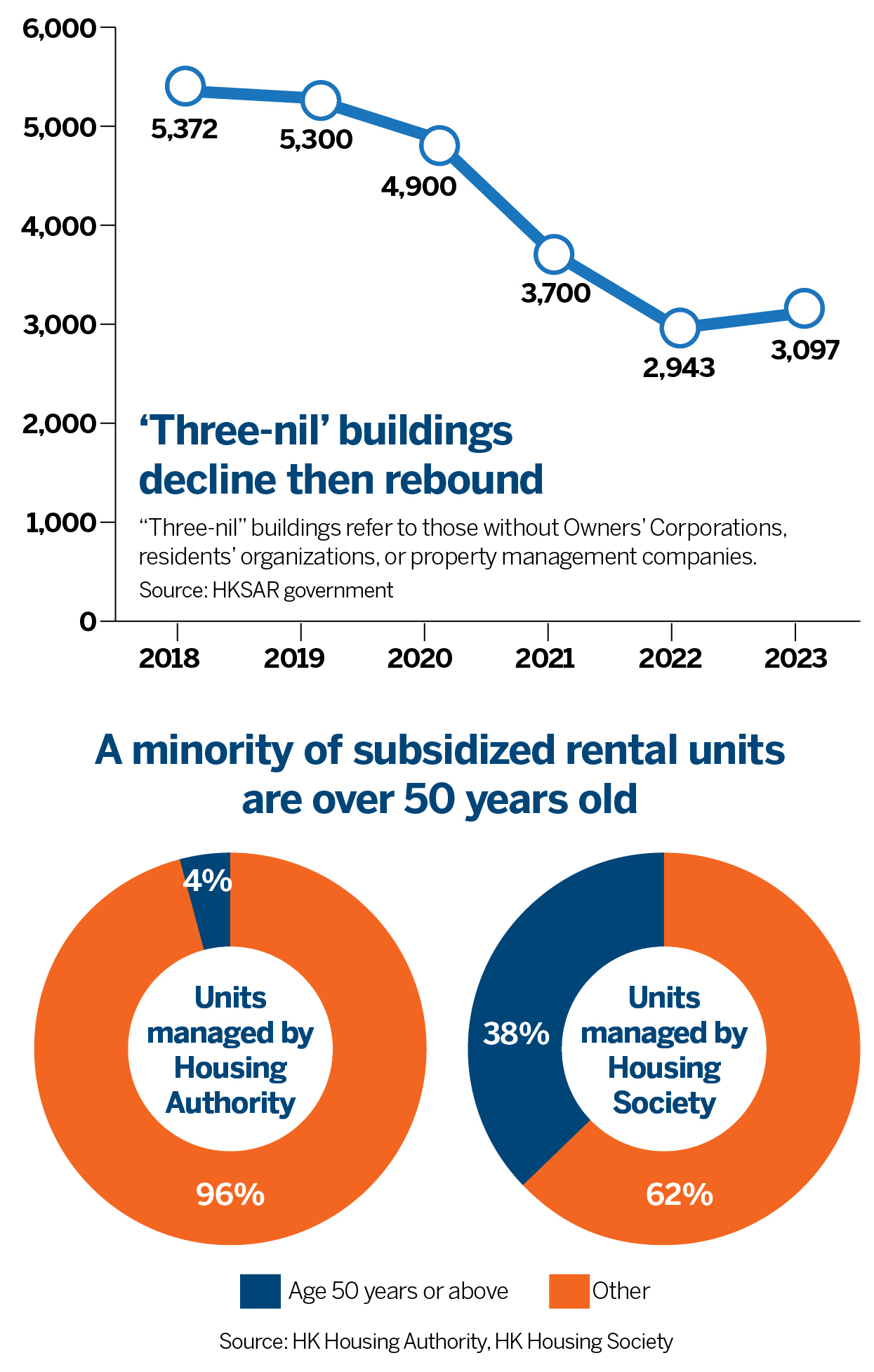
Mandatory inspection
In 2010, a five-story building collapsed from man-made structural damage, causing four deaths. The investigation report indicated sub-standard construction in 1955, and lack of maintenance thereafter.
The Mandatory Building Inspection Scheme was launched in 2012. Under this initiative, the Buildings Department picks around 600 buildings annually from the 19,800 above 30 years old, for owners to arrange thorough inspection and repairs. OCs can apply for government subsidies to partly cover MBIS compliance or other proactive repairs.
So far, the BD has served inspection notices on 7,800 buildings, about 39 percent of the above 30-year-old target group. Of these, about 45 percent are yet to complete repairs. That is an indication of the uphill task of monitoring and staying abreast of the rapid build-up of aging buildings.
Hong Kong Chief Executive John Lee Ka-chiu emphasized owners’ responsibility to ensure building safety, after official inspection orders for a building in Jordan were ignored and it caught fire in April, leading to the deaths of five residents. He added that the government will provide more assistance for buildings with high maintenance priorities. The city’s development chief, Bernadette Linn Hon-ho, hinted at a possible policy direction for all buildings reaching a certain age to proactively implement building inspections.
In the 2024 Policy Address, the chief executive pledged to assist more three-nil buildings. Data show more than HK$19 billion has been appropriated to subsidize owners to improve fire protection facilities, elevators, facades and other public repairs, benefiting thousands of aging buildings.
The BD has deployed drones and robotic technology to survey buildings with potentially higher risks and uses the data collected to create 3D models for follow-up work.
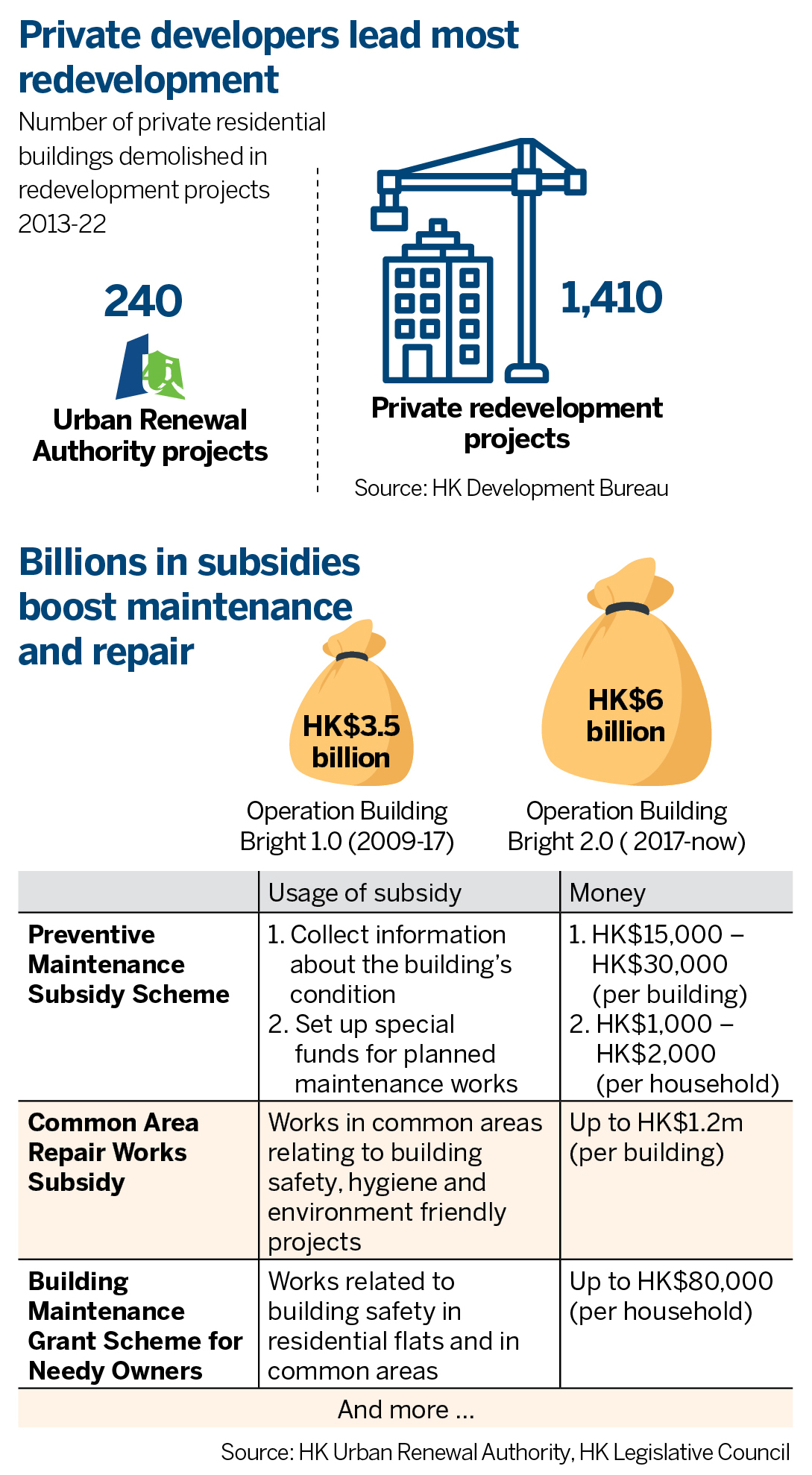
Trust deficit
According to Ryan Chuk Hing-toi, vice-chairman of the New Territories Association of Societies, “Many OCs are made up of retirees and housewives. You cannot expect them to have knowledge of engineering or building repairs.” There is a trust deficit inhibiting rectification works, he added. “Some consulting companies try to persuade OCs to accept expensive maintenance contracts. In other cases, individuals with construction business links try to influence OC elections for benefits,” he said.
Chuk noted that quarrels between apartment owners and OCs can develop when faced with large bills, continuing unresolved for years. He urged the government to step up supervision of OC elections to prevent election-rigging. The government has offered courses and free legal advice on building management to OCs, though Chuk said this was not sufficient.
He proposed developing a more comprehensive building rehabilitation company database, in which apartment owners could search for detailed information on consultants and contractors, to prevent them from being cheated.
In New York City, all buildings over six floors must inspect their facades every five years. Singapore mandates nonresidential buildings to inspect structures every five years, while residential towers have to be inspected every 10 years.
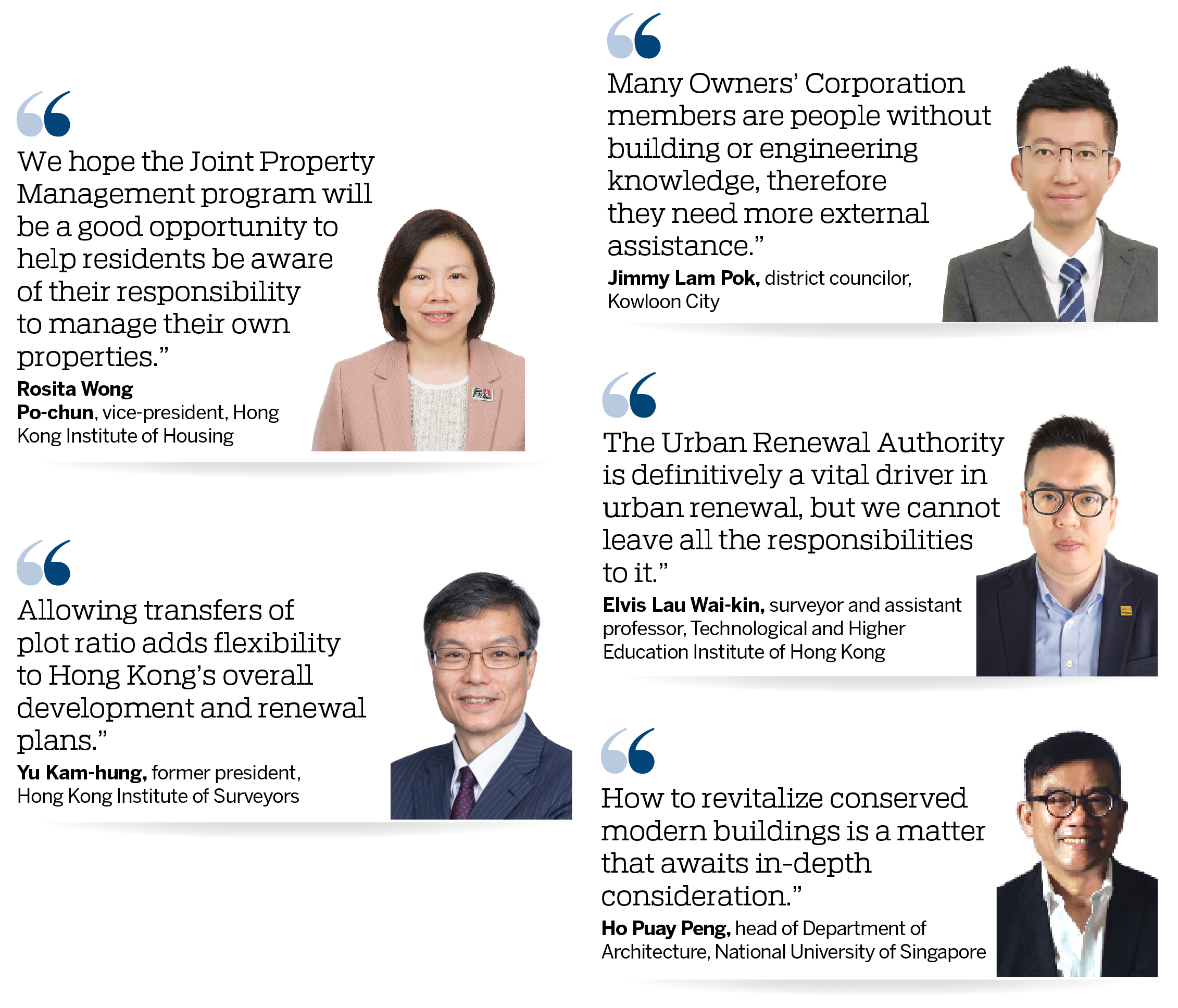
Preserve heritage
Identifying and preserving properties of “heritage value” is not given due consideration, amid the rush to demolish and redevelop real estate. Sentiments of culture and historical significance seldom count in commercial redevelopment.
Ho Puay Peng, head of the Department of Architecture at the National University of Singapore and former chairman of the School of Architecture at the Chinese University of Hong Kong, said many modern buildings with unique local characteristics were built during the city’s economic boom between the 1950s and 1970s. The Antiquities Advisory Board assessed 207 post-1950 buildings, classifying 120 as of historic value.
ALSO READ: CE supports HK's hosting of major events to boost economy
However, most of the city’s registered monuments and historic buildings are those established before World War II. Ho said some post-war historic buildings have already been torn down over the past decades. Ho urged the authorities to speed up assessment of post-war buildings before others with historical or cultural significance are lost.
Ho said the city’s historic building grading system is “a tiger without teeth” as many of the buildings are still in private hands. The system can only advise owners to protect buildings. Owners can still demolish their properties if they wish.
In the United Kingdom, donating historic buildings to the government or nonprofit organizations avoids inheritance tax, which is not the case in Hong Kong, said Ho. For buildings with cultural value, he suggested the government provide incentives such as land exchange to encourage heritage preservation.
What's next
1. Prioritize assistance to “three-nil” buildings.
2. Set up a maintenance fund for building inspections and repair.
3. Offer better urban renewal incentives to private developers.
4. Protect post-war buildings with heritage value.
5. Enhance education on maintenance and heritage value.
Contact the writer at williamxu@chinadailyhk.com


